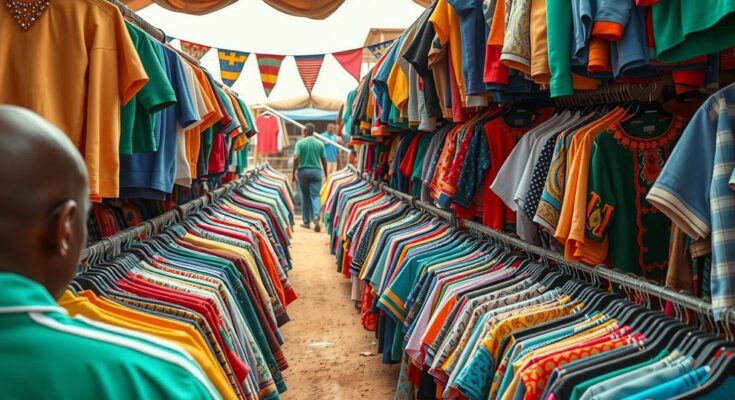In 2023, Kenya imported mitumba worth $298 million, becoming Africa’s largest second-hand clothing importer, surpassing Nigeria. This growth stems from rising demand and policy changes, including the elimination of key taxes, contrasting with neighboring countries imposing restrictions. The local textile sector faces pressures from the thriving mitumba market amid ongoing debates among policymakers regarding its socioeconomic implications.
Recent data from the Massachusetts Institute of Technology (MIT) reveals that Kenya imported mitumba, or second-hand clothing, valued at $298 million (Sh38.5 billion) in 2023. This positions Kenya as the largest importer of second-hand clothing in Africa, surpassing Nigeria, despite its considerably larger population. The increase reflects a 12.45 percent rise from 2022’s imports valued at $265 million (Sh34.28 billion).
The rising demand for affordable clothing drives this increase, with diverse second-hand items, such as underwear, trousers, dresses, and household textiles being imported. While Kenya’s imports surge, neighboring countries like Uganda, Rwanda, and Ethiopia are imposing restrictions to bolster their local textile manufacturing. Kenya’s significantly lower importation barriers contrast sharply with these nations’ policies.
Kenya’s surge is attributed to policy changes, notably the removal of the Import Declaration Fees (IDF) and the Railway Development Levy (RDL), making mitumba imports less costly. This amendment has faced criticism from local manufacturers and trade officials, expressing concerns that the changes could harm the domestic textile industry already struggling to compete with cheap second-hand imports.
In some East African Community (EAC) nations, regulations on mitumba are tightening, with higher duties and incentives established to encourage local textile production. For example, Rwanda has increased tariffs on second-hand clothes amid international pressures, particularly from the United States, the major supplier of mitumba.
Concerns arise over smuggling activities where a portion of the imported mitumba ostensibly meant for the Kenyan market is suspected of being diverted to neighboring countries. Kenya’s involvement in the African Growth and Opportunity Act (AGOA) creates pressure to maintain its open borders to second-hand clothing, particularly as nations like Ethiopia have faced removal from AGOA for such bans, prompting Kenya to tread carefully.
The ongoing discourse about Kenya’s mitumba market polarizes policymakers, with some appreciating the trade as a necessary support for low-income individuals, while others cite its detrimental impact on the local textile sector. The textile industry has long struggled despite several governmental interventions aimed at revitalization.
The topic of mitumba resurfaced during recent political campaigns, particularly when former Prime Minister Raila Odinga suggested a shift towards local production. This comment caused backlash among mitumba traders, leading to clarifications to assuage concerns regarding livelihood threats, which other political figures capitalized on for support.
Efforts to boost the textile industry have faced challenges, with the previous Jubilee government advocating for rejuvenation through its Big Four Agenda, and the current Kenya Kwanza administration employing a “value chain” strategy. Notably, the modernization of Rivatex East Africa has been a critical project aimed at revitalizing local production capabilities.
The government is proactively drafting the National Cotton, Textile, and Apparel (CTA) Policy 2024 to support cotton farmers and strengthen the local textile value chain. This comprehensive policy includes establishing textile value-addition centers across regions and enhancing production capacity while addressing unfair trade practices affecting local production.
The growth of Kenya’s mitumba market reflects substantial policy shifts and increased demand for affordable clothing. As the country emerges as the largest importer of second-hand garments in Africa, tensions between supporting local textile industries and the economic benefits of mitumba trade continue to create a divide among policymakers. Despite efforts to revamp local production, the dominance of the mitumba market poses ongoing challenges to Kenya’s textile sector.
Original Source: eastleighvoice.co.ke




